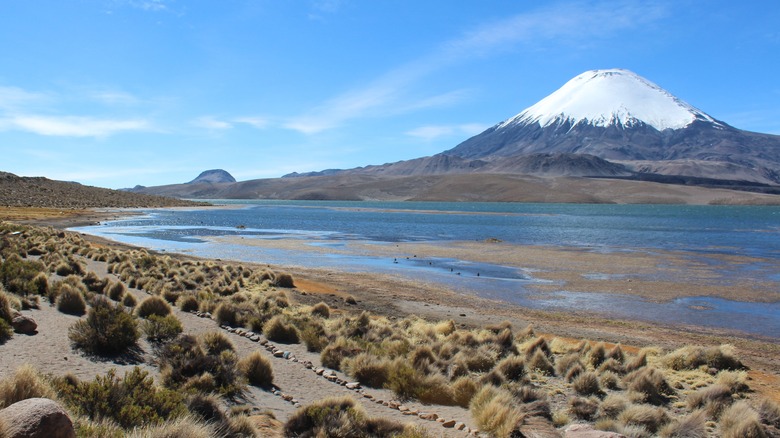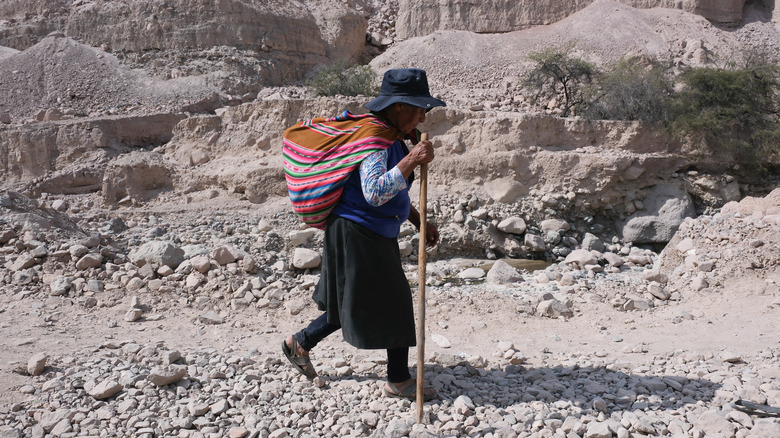One Of The World's Highest Lakes Is Flocked With Flamingos And Cradled By Twin Volcanoes
The Chungara Lake Biosphere Reserve may not carry the same fame as the Atacama Desert's moon-like valleys or the frozen delights of Patagonia, but is certainly one of Chile's true hidden gems. While places like Villarrica National Park offer an accessible, whimsical forest paradise for a casual hike, exploring this high-altitude region, at nearly 15,000 feet above sea level, requires preparation. Visitors need time to acclimatize, but those who do are rewarded with one of Chile's most breathtaking and surreal landscapes.
Those aiming to explore the beauty of the biosphere reserve, located near the Bolivian border, are encouraged to follow the local tradition of chewing coca leaves to help ease the effects of altitude sickness before tackling long treks. Once visitors get used to the thin air, they can begin to marvel at the spectacular panoramas of the nearby dormant Parinacota and Pomerape volcanoes. Adventurous trekkers have taken on both volcanoes, but with elevations exceeding 20,000 feet, these high-altitude climbs require proper mountaineering gear and serious caution.
A wildlife wonderland where birds, mammals, and rodents coexist
Those flying into Chacalluta International Airport in Arica from either the Chilean or Bolivian capital will just over three hours later be able to feast their eyes on some of the world's most incredible biodiversity. After taking the ascent through the winding roads of Northern Chile, visitors to Lake Chungará will discover animals they will likely never have seen before, such as ñandus, also known as rheas. Nestled between the two aforementioned volcanoes live such a diverse range of creatures. Seeing these species coexist in the wild is every bit as memorable as coming to Chile to view its iconic penguins.
In Lake Chungará alone pumas, alpacas, and rabbit-like vizcachas can all be found living in harmony. This is made even more special amidst the backdrop of the pink flamingos grazing gracefully on the water. Three of the six species of flamingos in the world can be found in Chile, and the ones at Lake Chungará are distinct due to their red knees and feet on their gray legs. Budding photographers can practice their camera skills in this extraordinary ecological environment and can channel their inner David Attenborough as they admire the animals on display.
Lake Chungará's sacred landscape shrouded in mysticism and spirituality
The Chilean Altiplano is not just a cameraman's haven, but it also has plenty to offer for those interested in spirituality and mysticism. Many travel to Chile's Easter Island to get a greater sense of the country's indigenous culture; however, the impact of the nation's varied indigenous groups is pronounced at Lake Chungará as well. At the center of Lauca National Park, the lake holds special meaning for the Aymara people, one of the main indigenous groups in northern Chile. The Aymara named the area "moss on a stone" in their mother tongue. This seemingly makes reference to the surprising flora and fauna that grow on its rocks at high altitude. In the surrounding park, the Aymara people conduct rituals and make offerings to Mother Earth, or the Pachamama, as she is known in Chile. Visitors may witness one of these ceremonies in which stones are laid to give thanks to the mountain spirits.
Indigenous communities like the Aymara believe the lake has spiritual significance. The spirituality of Lake Chungará is closely tied to the legend of the Payachatas, a story about how Mother Nature, in an act of divine intervention, flooded the region to end the violence between two warring tribes. Whether drawn by the flamingos, the volcanoes, or the indigenous mysticism, travelers can find in Lake Chungará an abundance of everything.


